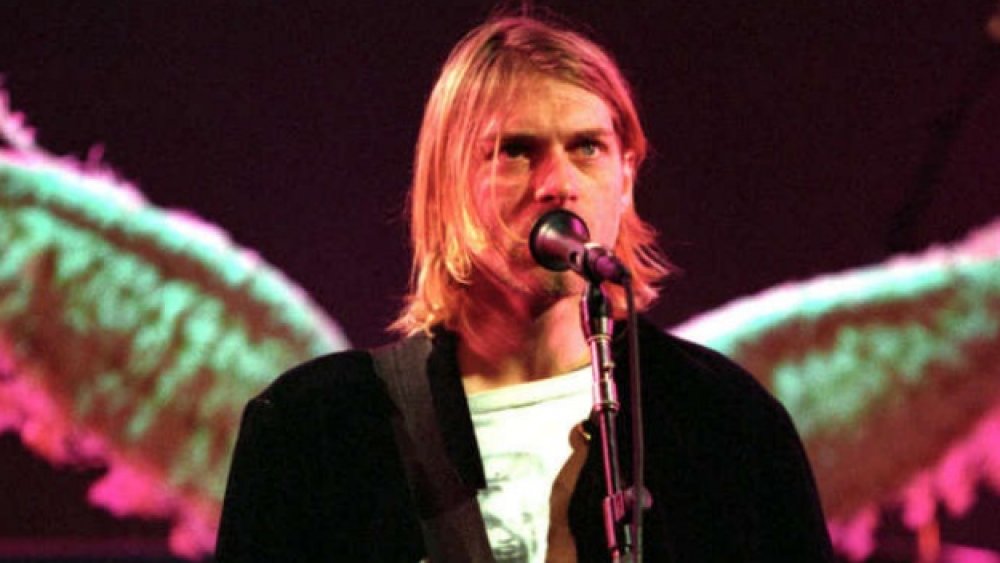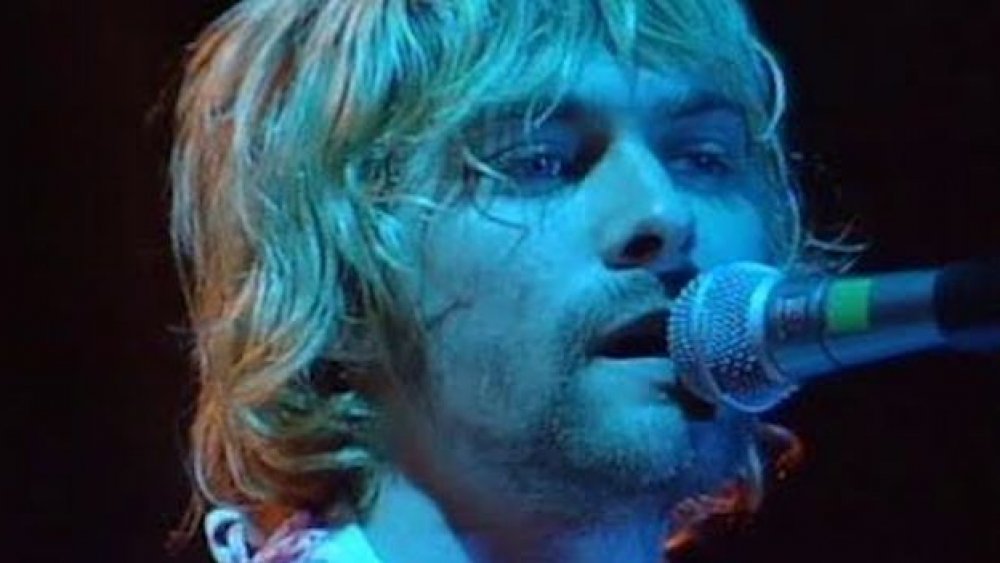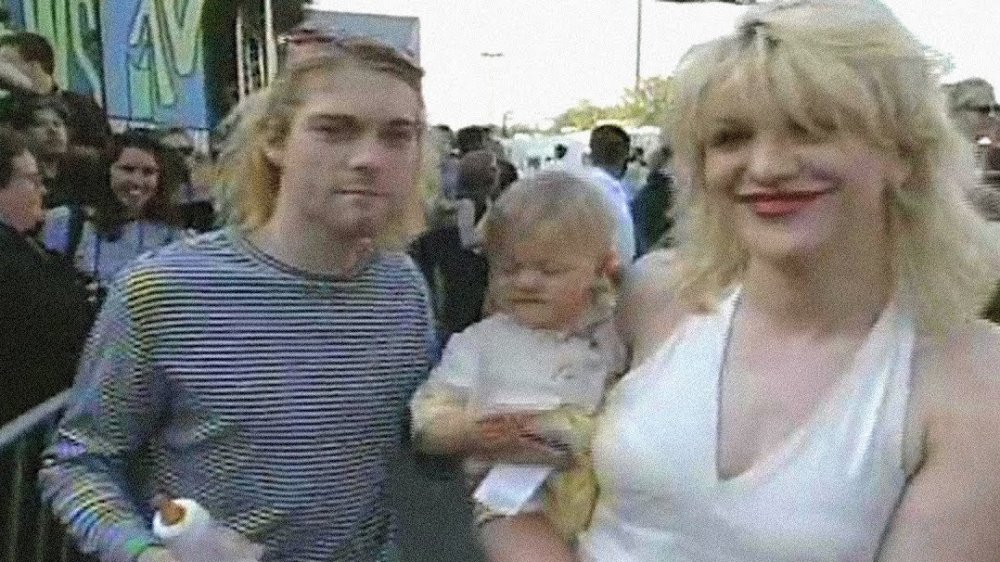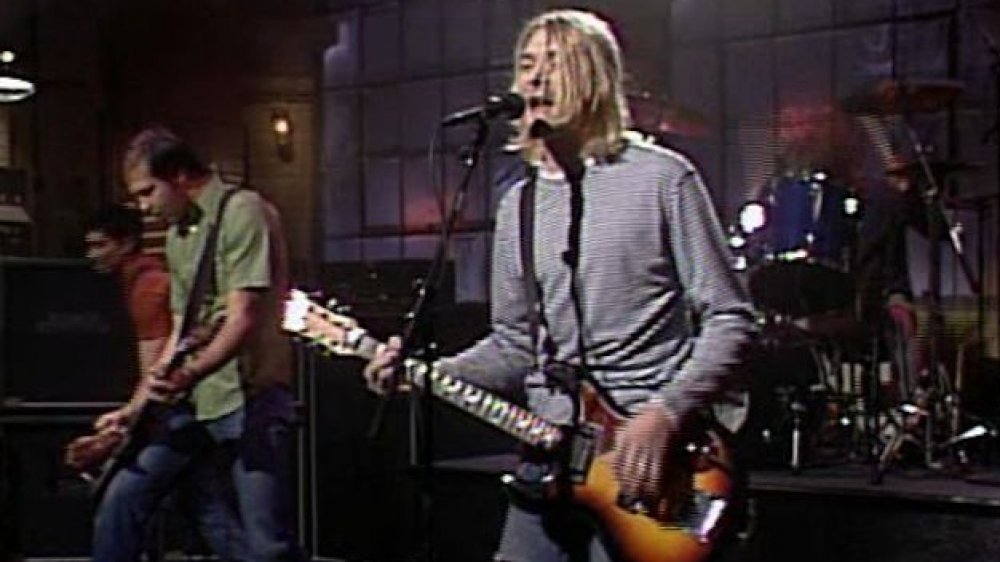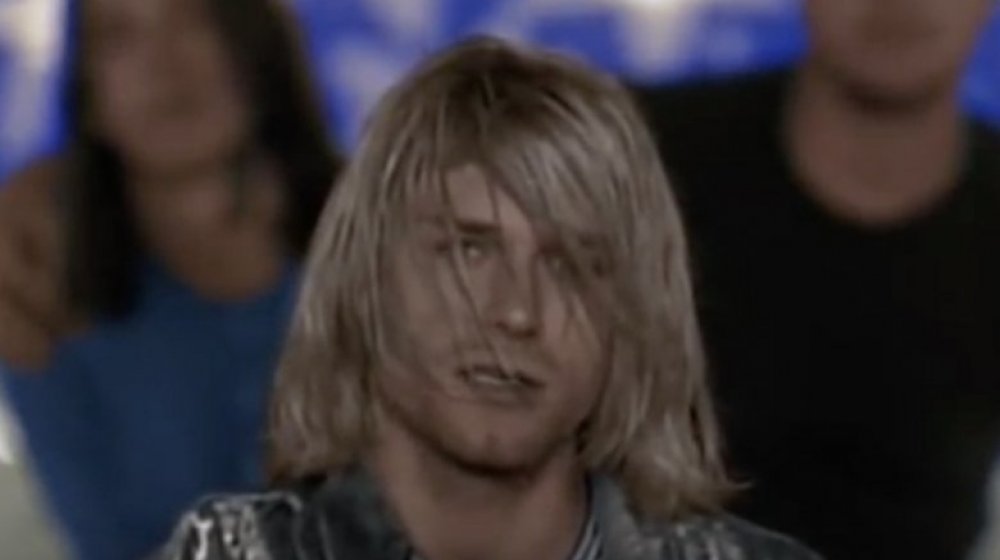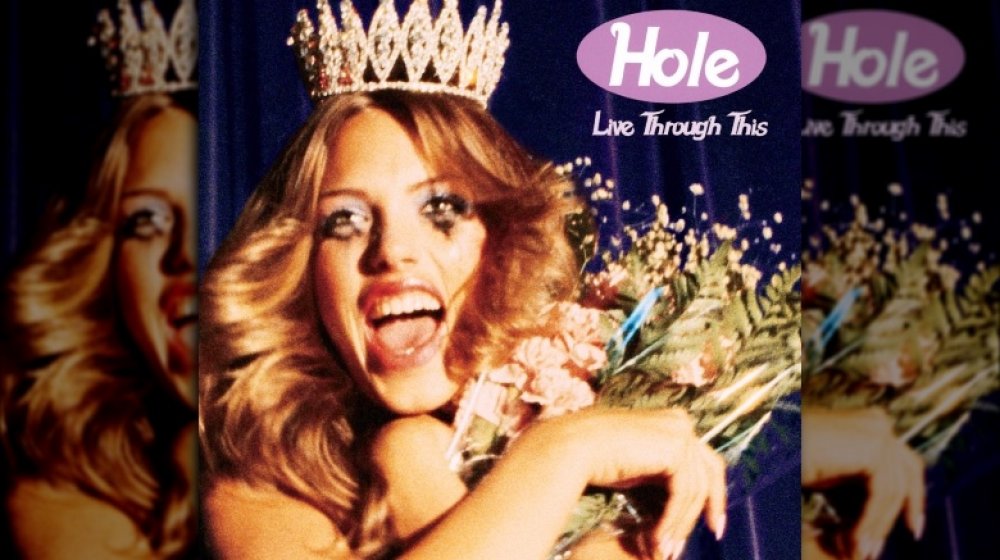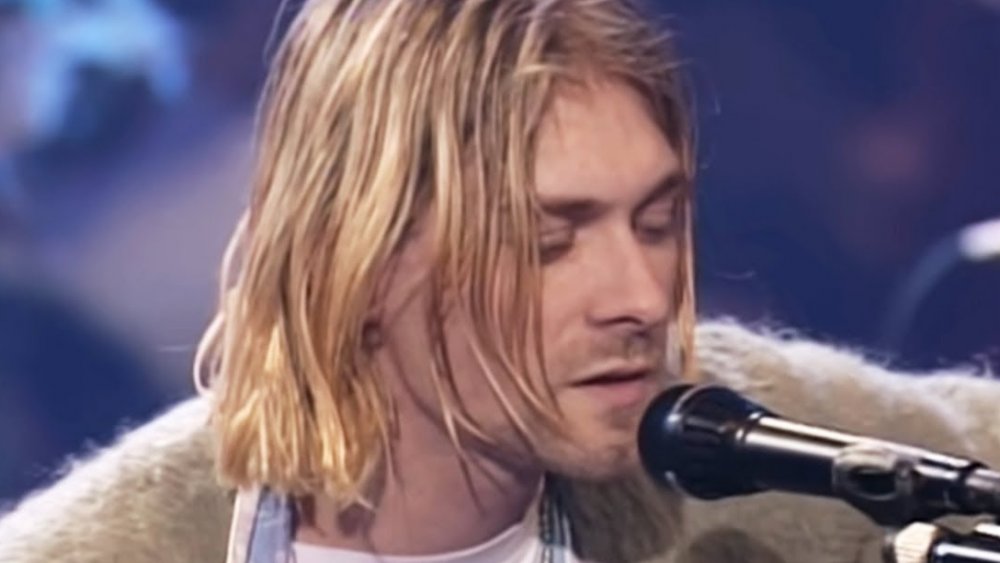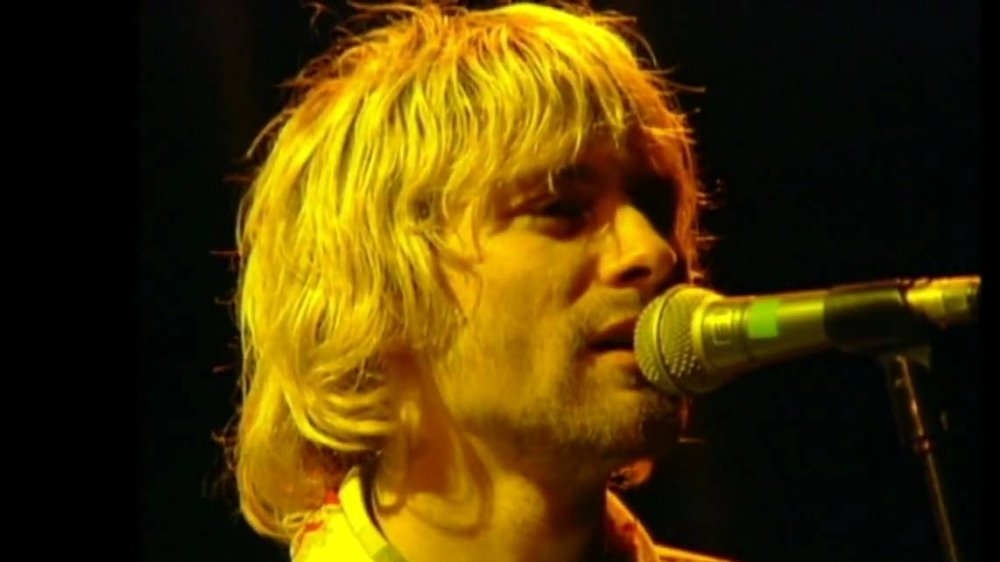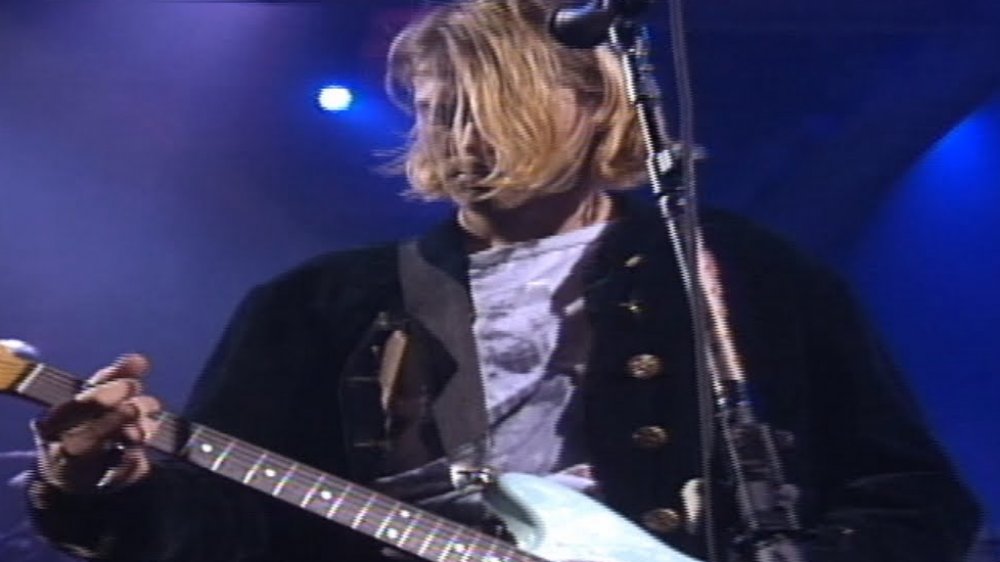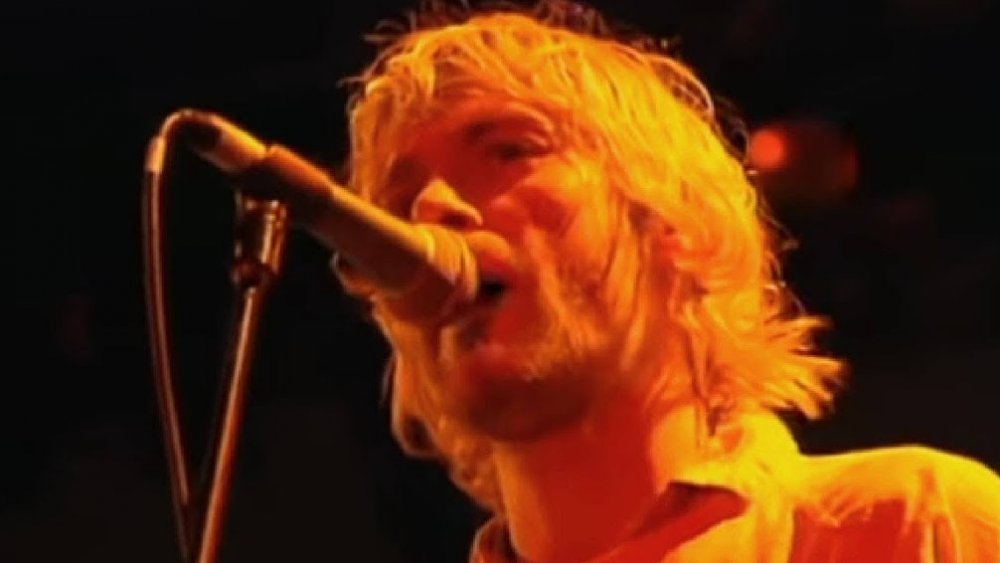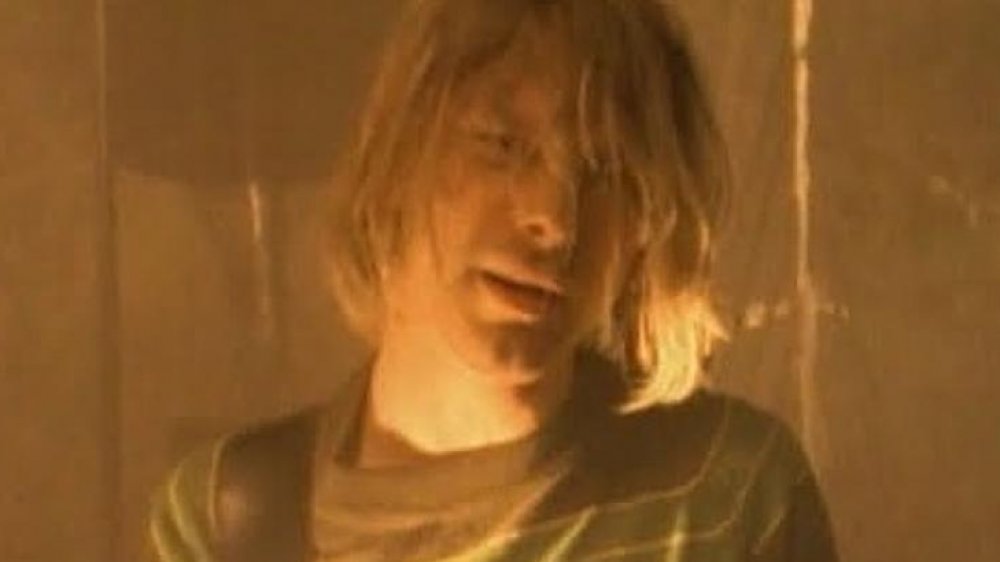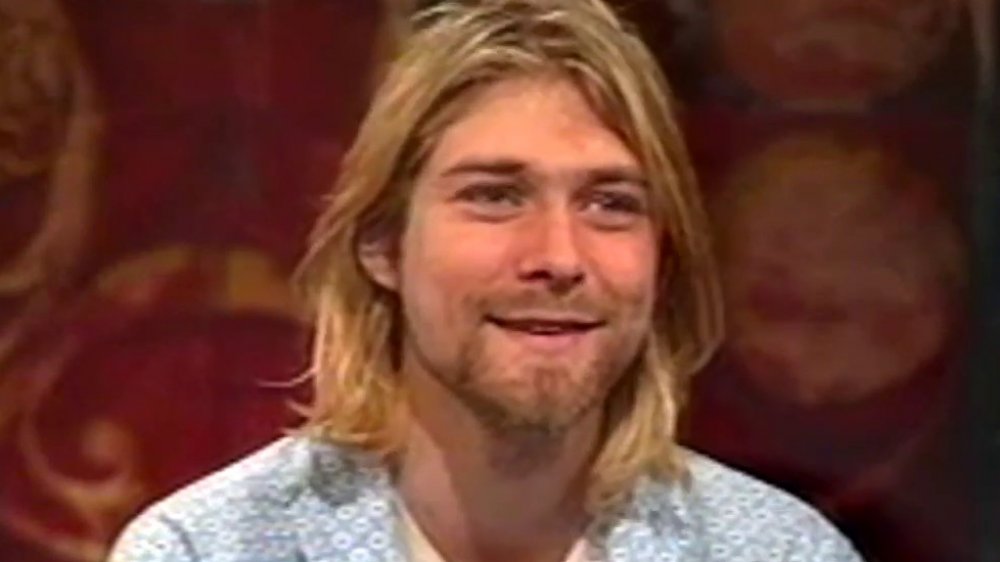What The Final 12 Months Of Kurt Cobain's Life Was Like
Emerging from the Pacific Northwest with their down-tuned guitars and songs of disaffection, Nirvana became the quintessential rock band of the '90s. As part of the Seattle-based grunge rock scene, bands like Nirvana brought a new, murky, but melodious sound — one part metal and one part punk. Nirvana lead singer and chief songwriter Kurt Cobain struggled mightily with stardom and bearing the weight of his generation's problems. He let the music speak for itself with thunderous classics like "Smells Like Teen Spirit," "In Bloom," "Sliver," "Heart-Shaped Box," and "All Apologies." Cobain was soon one of the most famous people in the world, partly for his work in Nirvana and partly because of his tumultuous offstage life with wife and fellow rock star Courtney Love.
By early 1993, things were going pretty good for Cobain, it would seem — all that rock star stuff plus a new baby daughter. Tragically, it would prove to be the last year of his life. Here's what occupied the Nirvana singer's thoughts and time over the final 12 months of his brief, 27-year life.
Authorities often visited the home of Kurt Cobain
In September 1992, Vanity Fair published journalist Lynn Hirschberg's profile of Kurt Cobain and Courtney Love, which detailed the couple's experiences with heroin and strongly suggested that Love used the drug while pregnant with daughter Frances Bean. Shortly after the issue hit newsstands and caused a fervor, child welfare services temporarily removed the infant from her parents' custody. After a family court decision in late March 1993, according to Rolling Stone, Los Angeles officially ended its supervision of the Cobain household. All was apparently well and good for only about six weeks, though.
On May 2, 1993, Cobain returned home to the family's Seattle homestead trembling and in a dazed state. Love determined that her husband was exhibiting the telltale signs of a heroin overdose and tried to end the incident by orally administering a Valium, three Benadryl tablets, and four Tylenols with codeine added, as well as injecting a dose of buprenorphine, a controlled substance that can reverse the effects of too many opioids. Cobain recovered and wasn't arrested, even though the police report cited his heroin use.
Just over a month later, on June 4, 1993, police once again visited the home at Love's request. The couple had engaged in a heated argument, after which Cobain was charged with domestic assault and had his guns confiscated. Love said the fight started over Cobain's gun ownership, while Cobain later told a friend that it was more of a confrontation about his drug use.
Kurt Cobain memorably attended the 1993 Video Music Awards
Forever the cooler, younger, and hipper alternative to the much more mainstream and older-skewing Grammy Awards, the MTV Video Music Awards celebrated its tenth iteration in September 1993. The evening confirmed Seattle as the dominant musical hot spot of the early '90s, as grunge bands won big. Pearl Jam took home four Moonman statuettes (including Video of the Year) for "Jeremy," while Nirvana won Best Alternative Video for "In Bloom." But it was Kurt Cobain who stole the show. Cobain treated the VMAs like he did all the other trappings of rock star fame — with humor and a pronounced lack of formality. On the red carpet, he somehow stole the focus away from the likes of more fabulously dressed celebrities like Lenny Kravitz, RuPaul, and Shaquille O'Neal, dressed in a striped shirt and sporting messy hair. He also brought along wife Courtney Love and their cherubic baby Frances Bean Cobain, who mugged for cameras and rode around on her dad's shoulders.
Cobain seemed to be having fun (going so far as to try to take off his pants during his acceptance speech), although he hadn't really wanted to go. "There was a lot of pressure from MTV for him to attend," Nirvana manager Danny Goldberg told The Hollywood Reporter. "He wasn't crazy about the idea of awards shows, but he liked having his videos played on MTV and he didn't want to p*ss them off."
Nirvana played Saturday Night Live
By the fall of 1993, Nirvana was one of the biggest bands in the world — if not the biggest — with a highly anticipated follow-up to Nevermind primed for release. On September 25, 1993, Cobain and company locked down a prestigious gig: musical guest on the season premiere of Saturday Night Live. The host that evening: NBA star Charles Barkley, upon whom Nirvana certainly made an impression. "First of all, they were fantastic. All the guys were really nice, he said on The Dan Patrick Show.
The host and band dressing rooms were adjacent, and Barkley kept his door open because he "had people coming in and out." Nirvana's members kept theirs shut, because they were smoking marijuana in there. "Every time those guys from Nirvana opened their locked door, I got a contact high. It was like one of those big mushroom clouds came," Barkley explained. The band performed two songs from the forthcoming In Utero: lead single "Heart-Shaped Box" and "Rape Me," an anti-rape song that was censored as "Waif Me" in versions of the album sold in big-box stores.
Nirvana released In Utero
After helping to popularize grunge with the 1991 album Nevermind – which ultimately sold ten million copies – Nirvana's next album was extremely anticipated. In September 1993, In Utero sold 180,000 copies in its first week and debuted at #1 on the Billboard album chart. It's remarkable that anybody got to hear the record at all. Label DGC didn't like it, and Kurt Cobain and Nirvana headed into the studio to quickly remix the album, hiring famed R.E.M. producer Scott Litt to do so after original producer Steve Albini refused to return. And when it was released, K-Mart and Wal-Mart initially wouldn't stock the album, squeamish about some of its ghoulish cover art.
To spread the word of In Utero, Nirvana set off on its first large-scale tour in two years, in October 1993. It was not without its problems. At one of the first stops, night one of a two-night stand at Chicago's Aragon Ballroom, vocal and guitar monitors were so problematic as to render the concert middling at best – Rolling Stone reported that the packed house booed the band. A planned six-week European leg of the tour wasn't completed. After a show on March 1, 1994, in Munich, Germany, Cobain suffered a case of bronchitis so bad that he couldn't sing. A few days later, he fell ill in Rome, and those personal health reasons would mark the end of the In Utero promotional swing.
Kurt Cobain helped guide the recording of Hole's Live Through This
Kurt Cobain and Courtney Love were grunge rock's king and queen, the most captivating and controversial musical married couple since John Lennon and Yoko Ono. The pair married in early 1992, just a few months after Love's band Hole released its first album, Pretty on the Inside. The group signed with Geffen subsidiary DGC for its second LP and major label debut, Live Through This, and by the time recording began, Nirvana was massively popular.
As Cobain was close with both lead singer Love, obviously, as well as the band's guitarist and other main songwriter Eric Erlandson, it was a no-brainer for Hole to involve Cobain in the creation of the new record. Seeing and enjoying Radiohead's summer 1993 MTV hit "Creep," Cobain suggested the band "get the Radiohead guy," Erlandson told Spin. That was actually two guys: Paul Q. Kolderie and Sean Slade. And after convincing Love that the drummer "is the most important person in your band," she hired new member Patty Schemel, on Cobain's suggestion.
As Love and Cobain adjusted to being new parents while living in Los Angeles, Erlandson and Schemel rehearsed at a studio in Cobain's Seattle-area home. Attempts were made for Cobain to perform on the album, but they didn't go so well. "I remember he was on so much Klonopin," Schemel recalled, leading to what Erlandson remembers as "mumbling harmonies over a couple songs."
Nirvana went unplugged
In November 1993, Nirvana enjoyed a rite of passage reserved for only the most important rock stars of the era: It got to record an episode of Unplugged, the MTV concert series where bands play their most famous songs without the aid of loud rock instruments like electric guitars and keyboards. (So they play with acoustic guitars.) At Sony Music Studios in New York City, and with a band bolstered by additional guitarist Pat Smear, cellist Lori Goldston, and members of the Meat Puppets, Cobain wailed his way through gently strummed and lightly drummed songs that were otherwise Nirvana thrash-fests, including "All Apologies," "On a Plain," and "Come as You Are."
According to The Ringer, Cobain gently tweaked the format of the show to make it more special. He helped design the set, ensuring that it was covered in black candles and lilies, and eschewed Nirvana's substantial catalog in favor of covers, including three Meat Puppets songs, Lead Belly's standard "Where Did You Sleep Last Night," and David Bowie's "The Man Who Sold the World." Later released in an edited form as MTV Unplugged in New York, it went five times platinum and won Nirvana its only Grammy, for Best Alternative Music Album.
Kurt Cobain tried to commit suicide in early 1994
The In Utero tour landed Kurt Cobain in Rome in early March 1994. That's where he nearly died, after, as the Los Angeles Times reported, Cobain fell into a coma. After he ingested too much champagne as well as pills in a hotel room, paramedics rushed him to the emergency room at Umberto I Polyclinic Hospital. His stomach was pumped and cleared of what doctors said were anti-influenza and throat health drugs. About 12 hours later, Cobain seemed to be recovering. "Kurt opened his eyes, he moved his fingers, and he responded to his name — those are good signs," Nirvana manager Janet Billig said. "It's very serious, but based on what we've been told by the doctors we are optimistic that he will make a full recovery."
But apparently, all of that was nonsense which shrouded the real truth: Cobain had actually attempted suicide. Courtney Love told Rolling Stone in 1994 that Cobain had grown extremely depressed on the road, so she joined him in Rome. Later that night, Love awoke to find Cobain not lying next to her. "He was at the end of the bed with a thousand dollars in his pocket and a note saying, 'You don't love me anymore. I'd rather die than go through a divorce.' " Love said that Cobain had ingested "50 f*cking pills" out of "a definite suicidal urge." Rolling Stone confirmed that the pills pumped from the singer's stomach were Rohypnol, a powerful tranquilizer.
Kurt Cobain's friends and family staged an intervention
Just a few weeks after Kurt Cobain's attempt at taking his own life in March 1994, Courtney Love attempted to arrange an intervention with counselor Steven Chatoff to help her husband deal with his many demons. "They called me to see what could be done," Chatoff told Rolling Stone. "He was using, up in Seattle. He was in full denial. It was very chaotic. And they were in fear for his life."
In advance of the intervention, Chatoff consulted a number of Cobain's friends and relatives, one of whom tipped off the singer, leading to a cancellation. After firing Chatoff, Nirvana's management company arranged for another intervention at Cobain's home in Seattle, per Biography. About a dozen people attended the intense, five-hour meeting on March 25, 1994, including Love, Nirvana bassist Krist Novoselic, and occasional guitarist Pat Smear. Among the ultimatums issued to Cobain, should he not seek medical and professional assistance in the form of checking into a drug rehab facility: Love said she'd leave him, and Novoselic and Smear said they'd dissolve Nirvana.
Love then flew to Los Angeles and enrolled herself in a drug rehab program. Cobain stayed behind in Seattle and dropped by the home of friend and firearm enthusiast Dylan Carson to ask for a gun, ostensibly to scare off trespassers on his property. Together, they bought a 20-gauge shotgun and ammunition. Cobain then left the gun at home before boarding a flight to LA to enter rehab.
Kurt Cobain sought treatment, albeit very briefly
Kurt Cobain acquiesced to the wishes of his wife and bandmates, and in late March 1994, he flew to Los Angeles to check into the Exodus Recovery Center. Nirvana guitarist Pat Smear and an employee of the band's management company met him at Los Angeles International Airport and drove him to the rehab facility in Marina del Rey, California, according to Rolling Stone. On April 1, he called Courtney Love, reportedly telling her, "Courtney, no matter what happens, I want you to know that you made a really good record," and, "Just remember, no matter what, I love you."
That would mark the final conversation between Cobain and Love. Later that day, at about 7:30 PM, Cobain informed an Exodus staff member that he was going outside to smoke a cigarette but instead managed to scale the six-foot-tall brick wall that surrounds the property. The following day, April 2, Love hired private investigators to find Cobain and also canceled his credit cards. By that point, he had returned to Seattle, where he was purportedly spotted by one of his daughter's nannies. His location still in doubt on April 4, Cobain's mother Wendy O'Connor reported him missing, suggesting that her son could be suicidal or might be out trying to score drugs. Other accounts say Cobain wandered around a Seattle park and spent some time at his other home outside Seattle, in the town of Carnation.
Kurt Cobain went missing, and then his body was discovered
Sadly, the outcome of Kurt Cobain's disappearance that his loved ones most feared turned out to be true. According to a police report (via The Smoking Gun), on April 8, 1994, the body of the Nirvana frontman was discovered in the greenhouse of his home on Lake Washington in Seattle, by an electrician who had been hired to work on a security system. Near Cobain was a 20-gauge shotgun with expended shells, and he had suffered a head wound, evidence of a self-inflicted gunshot as the cause of death. He also left a note, addressed to Boddah, a comforting childhood imaginary friend, and signed it "Peace, love, empath." He also addressed his wife: "Please keep going Courtney, for Frances."
If you or anyone you know is having suicidal thoughts, please call the National Suicide Prevention Lifeline at 1-800-273-TALK (8255).
Kurt Cobain was working on a solo album
Nirvana was on the verge of flaming out in early 1994. Not only had some of its personnel threatened to end the band should Kurt Cobain not go to rehab, but the group canceled its Lollapalooza slot in April 1994, just before Cobain's death. Its members were eager to pursue professional life outside of Nirvana, such as solo work. Dave Grohl had quietly written and recorded demos of several songs (ultimately forming the Foo Fighters), and Cobain was working on a standalone project, too.
According to Hole guitarist and Cobain friend Eric Erlandson, Cobain was in the midst of working on a solo LP. He "was headed in a direction that was really cool," Erlandson told Fuse. "It would have been his White Album," he added, comparing Cobain to no less than the Beatles. The guitarist added that he was "really excited about some of the stuff" and saw Cobain play it for him and that there was at least a home recording of a famous cover, which Erlandson said was "a very sweet, just touching song." Perhaps it's the Beatles' "And I Love Her," which showed up on Montage of Heck: The Home Recordings, a soundtrack to a Cobain documentary.
